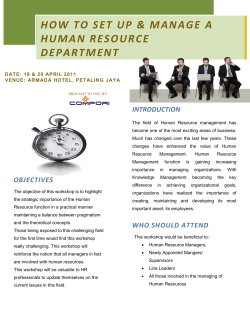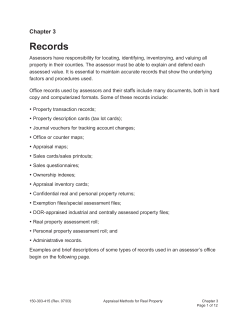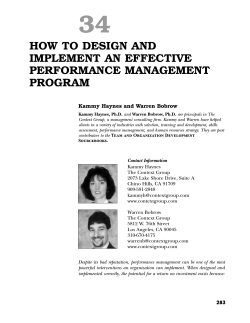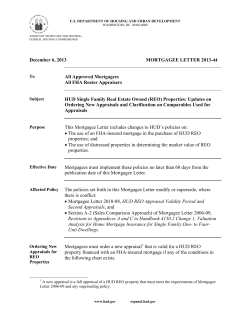
Document 186940
A DFID practice paper How to note FEBRUARY 2009 A strengthened approach to Economic Appraisals What this How To Note covers This note provides a standard outline for an economic appraisal. For each section of the appraisal, it provides an overview of the appropriate content and indicates other documents that provide more detailed technical guidance on appraisal issues. Additional support on how to apply this guidance to a range of DFID interventions will be provided through annotated good practice examples. The note is aimed primarily at economists, to enable them to put economic appraisals into context, and to provide sufficient guidance to plan a rigorous appraisal. Non-economists may also benefit from seeing what is expected from them in terms of laying the necessary groundwork for economists. What is an economic appraisal? Before considering implementing an intervention, all policy staff should ask what alternatives exist to achieve its objectives, and whether the benefits are likely to justify the costs. Just as importantly, we need to know whether interventions are designed to maximise positive impacts and minimise negative impacts. An economic appraisal provides a systematic and technically sound way of addressing these questions. It never provides complete answers but it nevertheless provides an informed base from which to make further arguments. Why do we need a strengthened approach to economic appraisals? • To make it more likely that we don’t just do good things, we do the best things we can do with the resources we have; • To make explicit the assumptions and analysis that underpin our decisions so that those assumptions can be tested, challenged and improved, thereby promoting better decisions and designs; • So that we can assure all our stakeholders, including parliamentarians, civil society and the public that we use their money in the most effective way possible to deliver development outcomes. 1 Value for Money Department, FCPD What interventions require an economic appraisal? Economic appraisals can be applied to all types of DFID intervention – bilateral and multilateral projects and programmes, humanitarian interventions, core funding to civil society organisations and multilateral institutions. The sophistication of the techniques that can be used, and the depth of insight that can be given, depend on whether outcomes and impacts can be credibly quantified. One of the challenges over the coming months will be to see how far we can quantify complex results chains for interventions such as budget support, support to civil society, and impacts gained through influencing rather than through money. With the support of colleagues, economists should be encouraged to experiment with, and share their experiences of applying economic appraisal principles to a wide range of DFID interventions. When to do an economic appraisal? The simple answer is “as early as possible”. We must avoid economic appraisals being seen as the last hurdle before implementation. There are good reasons for this. Firstly, early appraisals can persuade colleagues to rethink poorly conceived proposals before too much time is spent on developing them. Secondly, good economic appraisals always reveal insights that inform policy design, and thereby improve value for money. The earlier these insights come, the better. How are we going to achieve this? Achieving these aims will require strong collaboration within project teams. Before economists can analyse the balance between the costs and benefits of an intervention, multidisciplinary teams must agree what the inputs, outputs, outcomes and impact are likely to be. This requires careful use of evaluation and research evidence, as well as expert judgement. Remember that quantification is not just for economists and statisticians – all professional cadres should contribute to quantifying inputs, outputs, outcomes and impact. Fortunately, through logframes, DFID already has a tradition of thinking about results chains. What does the strengthened approach to economic appraisals look like? The rest of this HTN gives standard headings for DFID economic appraisal write-ups, and a description of what information needs to appear under each heading. As the economist cadre renews its experience of conducting more rigorous economic appraisals, the standard outline may change to accommodate new ideas and better ways of presenting information. But for the time being, the outline reflects good practice across UK government departments with some tweaks to cater for DFID’s policy environment. A word on transparency The credibility of an economic appraisal write-up is enhanced if the reasoning behind its conclusions is transparently communicated. A good question to ask yourself is “Using the evidence and assumptions that I have presented, could a decision maker reasonably be expected to work out how I have reached my conclusions?” 2 Standard Outline for Economic Appraisal Reporting 1. Rationale for intervention This section should provide: a) A detailed description of the problems that we are seeking to solve. Typically these will be one or more of1: i) Inequitable distribution of resources leading to inequitable outcomes. ii) Loss of economic efficiency through market failures (not to be confused with markets producing inequitable outcomes for the poor) iii) Government inefficiencies and failures in implementing policies designed to correct inequities and market failures. Empirical evidence of the existence and severity of the problems should be presented. b) A counterfactual of what would happen at outcome and impact levels if no new intervention occurred. The counterfactual must be quantified to the extent possible. 2. Options considered for tackling the problems The minimum number of options that an economic appraisal should consider is two – the proposed option and the counterfactual. The latter is usually expressed either as the “do nothing” option or, often more usefully, as the “do nothing more than is already being done” option. You should ensure that your analysis focuses only on incremental costs and benefits – that is, the changes that the proposed intervention generates over and above those of the counterfactual. This section must also summarise other options for solving the problem that were considered and the reasons why they were rejected. If no other options were considered, this should be stated and the reasons given. 3. Intervention logic and evidence For the proposed intervention, this section should make explicit the key assumptions that underpin the intervention logic (i.e., the links between inputs and outputs, outputs and outcomes, and outcomes and impact). You should comment on the strength of the evidence behind the assumptions. Much of the credibility of the economic appraisal rests on these assumptions being reasonable. This section should also identify assumptions that are particularly uncertain, and are therefore the focus of the sensitivity analysis that is reported in Section 7: Risks and Uncertainty. 4. Incremental costs This section should report the total incremental resource costs2 of inputs/activities for the intervention as a whole. You should state the contributions of all development partners, and estimates of any additional resource costs incurred by the private sector and individuals. The distribution of costs over time should be made clear. A table may be the best way to present the time dimension, and will allow readers to see clearly the level of costs borne by each party. The recommendation is that you do not present discounted values. Interpreting the meaning of discounted costs in 3 isolation of incremental benefits is difficult. Instead, discounted measures should be introduced in Section 6: Balance of Costs and Benefits. The section should not report the costs of adverse outcomes, which should be seen as “negative benefits” and deducted from the benefits stream. This approach allows decision makers to see transparently the values of the resources that are being invested by each party in the intervention. In estimating costs, you should be aware of “optimism bias”. This is the commonly observed phenomenon whereby “appraisers tend to overstate benefits, and understate timings and costs, both capital and operational” (Treasury Green Book). Guidance on how to deal with optimism bias appears in Chapter 5 of the Green Book. It discusses the use of empirical observations of past optimism bias to make adjustments. In some contexts, for instance infrastructural investments, DFID economists and technical advisers may be able to adapt commonly used UK adjustments. However, in other cases, until a sufficient body of evaluation evidence has been established, judgements on whether and how to adjust for optimism will have to be made. 5. Incremental Benefits The section should start by identifying the units of benefit that the appraisal is based on. Every effort should be made to use units of benefit that describe impacts (i.e. changes in people’s welfare that can be measured by such things as improvement in health and wealth) or outcomes that have undistorted market prices (i.e., market goods whose consumption welfare effects have been valued at the margin in undistorted markets). This approach will push the analysis towards answering the questions “is this intervention worth doing?” and “how can we design the intervention to maximise its positive impact on welfare?” If evidence of links along the results chain is very weak, the appraisal will not be able to focus credibly on units of benefit that describe outcomes and impact. In such cases, you should state clearly that the available evidence does not allow DFID to estimate the welfare impact of the intervention, and that the decision to proceed would need to be made on other grounds. Nevertheless, the appraisal can still provide useful information to decision makers. For instance, a partial analysis of PRBS might focus on estimating operational and allocational efficiencies that increase the amount of money available for poverty reduction delivery. All other things being equal, you would expect that this increase in available funds would lead to poverty reduction. However, you may not be able to make a credible evidencebased case that this will definitely be so. Analysis of benefits should be conducted at an aggregate level, i.e. without attribution. This approach avoids double or under-counting benefits. Attribution of benefits to DFID and its partners should be analysed as a separate exercise (see Section 13: Attribution to DFID). Wherever possible and credible, outcomes and impacts should be valued in monetary terms or other standard aggregatable units (e.g., DALYs averted). Market prices for monetised benefits should be adjusted for any policy induced distortions (methods for doing this are described in Chapter 6 of DFID’s Investment Appraisal Guidance). Non-market goods should be monetised at the rates quoted in Section 15 of your appraisal Technical Note: Summary and Justification of Key Analytical Parameters. 4 Remember that we are only interested in incremental benefits (not gross benefits). DFID economists and other relevant advisers need to collaborate and think carefully about what will, and will not change between the counterfactual and the proposed intervention. Challenge from other colleagues should always be sought and careful consideration should be given to possible negative impacts. In particular, always be aware of possible displacement/substitution effects, whereby positive impacts in one part of the economy are offset by negative impacts in another part. The classic example is “crowding out” the private sector, which can result in a lost output and employment. Multiplier effects should generally be excluded because they rely on the existence of spare productive capacity that rarely exists in developing countries3. When estimating incremental benefits, always consider “optimism bias” (discussed in Section 4: Incremental Costs). The distribution of benefits over time should be made clear. A table may be the best way to present the time dimension. As with incremental costs, the recommendation is that you do not present discounted values for incremental benefits. Finally, this section should list all impacts (including negative ones) that have defied credible quantification. You should add statements describing how significant each unquantified impact is likely to be. 6. Balance of Costs and Benefits This is where you should report, where available, the best-estimate results from your incremental cost benefit analysis (CBA) or incremental cost effectiveness analysis (CEA). Chapter 5 of DFID’s Investment Appraisal Guidance prescribes what form of CBA reporting (IRR, CBR, NPV, etc) you should use for different circumstances. This best estimate should be presented in present values, or be derived from them. If a lack of evidence has meant that estimating the volume of benefits at outcome and impact levels has not been possible, yet you have monetised values for the units of benefit, you should consider conducting break-even analysis. The question that this analysis answers is: “How many units of benefit would the intervention have to generate before the value of the benefits outweighs the costs?” You must also add a credible assessment of how likely the break-even point would be reached. Where a proposed intervention has significant unquantified benefits, you should include a judgement of whether hypothetical inclusion of the impacts in the quantified analysis might change conclusions about the balance of costs and benefits. 7. Risk and uncertainty The process of identifying significant risks, their impact and their probability of occurring, should be a collaboration between advisers from relevant DFID cadres. Economists should then use this information to analyse the potential implications for the balance between costs and benefits. For cost benefit analysis, Chapter 9 of DFID’s Investment Appraisal Guidance describes how risk and uncertainty should be analysed and presented. Adjusting analytical results for varying attitudes to risk (usually risk aversion) should not be done. Instead, the results of sensitivity analysis should be clearly presented so that decision makers can make their own decisions on how the best-estimate results should be discounted for risk aversion. 5 Where formal cost benefit analysis has not been possible, you should still present qualitative analysis of the likelihood of risks and their potential impact on the balance of costs and benefits. This section should also describe relevant risks that standard cost benefit techniques do not usually capture. For earmarked funding to governments, multilateral organisations, and large civil society organisations, fungibility is always likely. You should comment on the overall quality of government, multilateral or CSO expenditure, how it aligns with stated poverty reduction objectives, and where money tends to be spent at the margin. This information will tell DFID and ministerial decision makers how likely it is that DFID would end up implicitly funding programmes and projects with low social returns. Ideally, for country offices, most of the information will be drawn from Country Planning documents, including the country governance analysis and fiduciary risk assessment. 8. Incidence of costs and benefits This section should summarise findings on who would bear the incremental costs, who would enjoy the incremental benefits, and how this allocation of costs and benefits would be distributed over time. Choosing the relevant groups to consider (e.g., local taxpayers, donor taxpayers, different types of private sector company, different categories of the poor, the wealthy elite, middle classes, women, men, young, old, and rural or city dwellers) will depend on the intervention in question. You should work closely with governance and social development advisers to analyse the distribution of costs and benefits. This collaboration should yield important information for inclusion in social development and political/governance appraisals. In particular, it should help to identify the equity implications of the proposed interventions, and the likelihood that political-economy constraints will threaten the achievement of intervention targets. 9. Competition assessment Where competition within the private sector of a partner country is likely to be affected by the intervention, you should conduct and report a competition assessment. Guidance for doing this is available on the economists’ teamsite. 10. Macroeconomic impact Unless economic growth is a clearly targeted impact of the intervention, the analysis summarised above will be conducted at the microeconomic level. You can not aggregate the microeconomic impacts from an intervention and call the result a macroeconomic impact. However, where relevant, you should report separately any evidence on the effects that the proposal will have on the macro economy (growth, inflation, employment, exchange rates, etc). If empirical evidence of macroeconomic impact is not available, and yet it seems likely that some impact would occur, this should be clearly stated and described. 11. Fiscal impact Where relevant, this section should cover: • Changes in public expenditures and revenues at both central and local levels; 6 • The extent to which costs will be recovered from beneficiaries. (Note that the effects of any cost recovery arrangements on demand and the distribution of benefits should be reported in the sections on Incremental Benefits and Incidence of Costs and Benefits). 12. Financial sustainability This section should cover: • Where relevant, the overall affordability of the government’s contributions to the intervention, paying particular attention to the effect of competing demands for budgetary resources. • The expected cash-flow and an assessment of whether recurrent expenditure requirements are likely to be met. 13. Attribution to DFID The default should be to present pro rata credit for producing benefits, based on DFID’s proportion of the overall value of the inputs to the project or programme. If you have reason to believe that DFID’s inputs will be more productive than the average productivity of all partners’ inputs, then DFID should claim greater credit for producing benefits than a simple pro-rata approach would suggest. This is most likely to occur where DFID earmarks its funding or uses its expertise and resources to increase government staff productivity, reduce transaction costs and/or increase the efficiency of project and programme spending. Qualitative and/or quantitative analysis of these effects should be presented and used to adjust DFID’s pro rata credit for producing benefits. It is possible that, in the absence of DFID’s involvement, a proposed multi-partner intervention would not be implemented. If this is likely, supporting evidence should be presented. In such cases, the inclination would be to attribute the majority of the benefits to DFID, while attributing marginal benefits to the other partners. However: • We lack robust and consistent quantitative methods for doing this; • We may tend to understate what positive action would take place in the absence of DFID’s involvement: and • We may tend to ignore situations where DFID is only a marginal partner. Normal practice should therefore be to avoid quantitative adjustments for catalytic or marginal effects. Instead a qualitative statement should accompany the quantified DFID attribution. If you believe that the case is so strong that a quantitative adjustment is warranted, you should argue the case with the Head of Profession or Chief Economist. 14. Summary and recommendations This short section should appear in the main text of the Project Document. It should summarise all the information contained in the economic appraisal write-up, and ensure that sufficient weight is given to important qualitative insights, acknowledgement of which will help decision makers avoid reaching poor conclusions on the basis of unqualified quantitative evidence. 7 15. Technical note: Summary and justification of key analytical parameters Where appropriate, this section should quote and justify: • The discount rate used. • The length of the appraisal period. • Values used for non-market goods (such as preventing a fatality, and environmental preservation), and their source. • Methods and values used for correcting large market distortions created by government policy (see Chapter 6 of DFID’s Investment Appraisal Guidance). Notes 1. The rationale for government intervention is explained well in Annex 1 of the Green Book http://www.hm-treasury.gov.uk/d/Green_Book2_03.pdf 2. Resource costs meant in the economic sense, to include financial as well as the value of in-kind contributions. 3. This is discussed on page 12 of Bridger, G.A. and J.T. Winpenny (1991) “Planning Development Projects: A practical guide to the choice and appraisal of public sector investments”, HMSO, London. VERSION 1.0 Issued 2 February 2009 8
© Copyright 2025





















